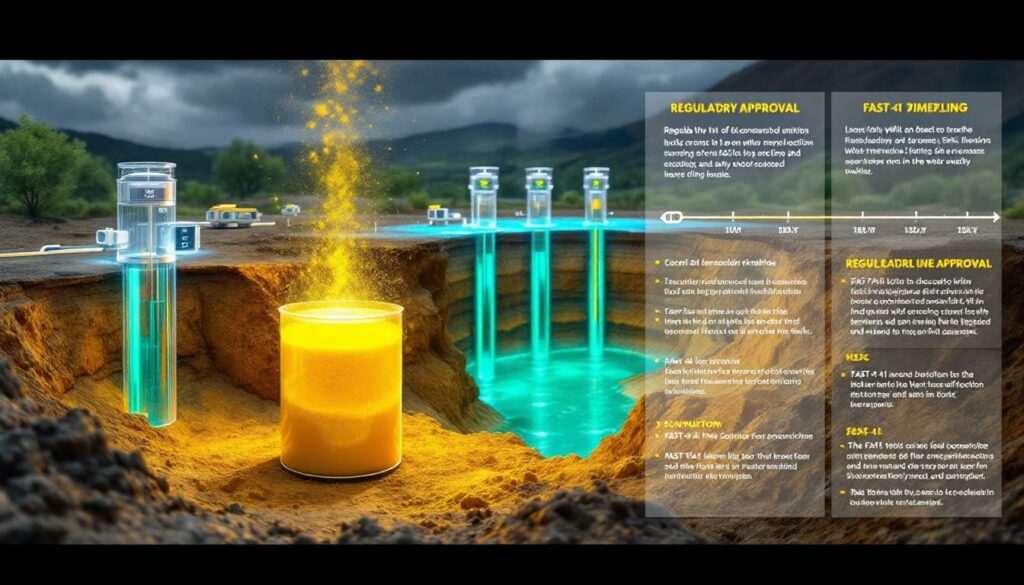What is In-Situ Recovery (ISR) Mining for Uranium?
In-situ recovery (ISR) mining represents a revolutionary approach to uranium extraction that differs significantly from traditional mining methods. Unlike conventional mining that requires removing and processing large volumes of rock, ISR extracts uranium directly from its underground environment without disturbing the surrounding landscape.
Definition and Basic Principles
ISR mining works by injecting a solution (typically oxygen-enhanced groundwater with sodium bicarbonate) through wells drilled into uranium-bearing sandstone formations. This solution, called a lixiviant, circulates through the ore body, dissolving the uranium minerals. The uranium-rich solution is then pumped back to the surface through production wells, where the uranium is extracted at a processing facility.
"In-situ mineral extraction combines drilling, rock fracturing and chemical leaching directly at the drill site," according to Mining Weekly's August 2025 report, highlighting the process's efficiency compared to traditional mining methods.
This technique leverages natural geological conditions to access uranium deposits that might otherwise be economically unfeasible to mine using conventional methods.
Key Components of ISR Systems
An effective ISR operation relies on several integrated components working together:
- Injection wells: Strategically placed wells that deliver the leaching solution into the uranium-bearing formation
- Production wells: Extract the uranium-rich solution after it has dissolved the target minerals
- Monitoring wells: Positioned around the mining zone to ensure environmental containment and detect any potential migration
- Header houses: Control centers that manage multiple injection and production wells
- Processing facilities: Where uranium is separated from the solution using ion exchange technology
- Restoration systems: Equipment designed to return groundwater to baseline or approved conditions after mining
The wellfield design is crucial, with wells typically arranged in patterns (five-spot, seven-spot) to optimize solution flow and uranium extraction boost.
Geological Requirements
Not all uranium deposits are suitable for ISR mining. The method requires specific geological conditions:
- Permeable host rock: Typically sandstone with sufficient permeability to allow solution flow
- Confined aquifer conditions: The uranium-bearing formation must be bounded by less permeable layers above and below
- Limited natural groundwater movement: Ideally less than 10 feet per year to maintain control of mining solutions
- Appropriate mineralization: Uranium minerals must be amenable to dissolution by the chosen lixiviant
- Sufficient uranium grade: Typically requires concentrations of 0.05% or higher for economic viability
These requirements explain why ISR mining is predominantly used in regions with specific geological formations, such as Wyoming's Powder River Basin, South Texas, and Kazakhstan's uranium belts.
Environmental Considerations of In-Situ Uranium Mining
ISR mining offers several environmental advantages over conventional mining, but also presents unique challenges that require careful management and regulatory oversight.
Groundwater Protection Measures
The most critical environmental consideration for ISR operations is groundwater protection. Comprehensive safeguards include:
- Extensive baseline water quality testing: Before mining begins, operators must establish pre-mining water quality parameters through multiple sampling events
- Multi-layered monitoring systems: Typically dozens of monitoring wells are installed around the mining zone in both horizontal and vertical dimensions
- Excursion control protocols: If monitoring detects solutions moving beyond intended boundaries, operations must immediately implement corrective actions
- Mechanical integrity testing: All wells undergo pressure testing to ensure there are no leaks or pathways for solutions to migrate to other aquifers
- Regular sampling and reporting: Ongoing water quality testing with results reported to regulatory agencies
These monitoring wells form a protective ring around the mining area, sampling water quality before, during, and after operations to detect any potential contaminant migration beyond the mining zone.
Reduced Surface Disturbance
One of the most significant environmental benefits of ISR mining is its minimal surface impact:
- Limited land disruption: ISR wellfields typically disturb less than 10% of the surface area compared to conventional open-pit mines of similar production capacity
- No waste rock or tailings: Since ore remains underground, ISR eliminates the massive waste piles associated with conventional mining
- Smaller processing facilities: Surface infrastructure is limited to wellheads, pipelines, and processing facilities
- Progressive reclamation: Areas can be restored as mining progresses, rather than waiting until the end of mine life
- Preservation of topography: The natural landscape remains largely intact throughout operations
This reduced footprint makes ISR mining particularly suitable for environmentally sensitive areas where conventional mining would face significant opposition.
Restoration Requirements
Post-mining groundwater restoration is a regulatory requirement for all ISR operations and typically follows a multi-phase approach:
- Groundwater sweep: Initially removing mining solutions by pumping water from the wellfield without reinjection
- Reverse osmosis treatment: Processing affected groundwater through RO systems to remove dissolved constituents
- Reductant addition: Often introducing chemicals like hydrogen sulfide to restore reducing conditions and immobilize metals
- Stabilization monitoring: Extended period of sampling to demonstrate stable water quality meeting restoration targets
Regulatory standards typically require restoration to baseline conditions, although alternative standards may be approved if baseline cannot be reasonably achieved and the resulting water quality poses no threat to human health or the environment.
Environmental Disclaimer: While ISR mining generally has a smaller environmental footprint than conventional mining, proper implementation of monitoring systems and restoration protocols is essential. Regulatory compliance and technical expertise are critical to ensuring environmental protection.
How Does the FAST-41 Approval Process Work?
The regulatory approval process for new mining operations has historically been complex and time-consuming. The FAST-41 program represents a significant shift in how critical infrastructure projects, including uranium energy in-situ mining approval, navigate federal permitting.
Origins and Purpose of FAST-41
"FAST-41 is a federal initiative launched in 2015 to streamline approvals of critical infrastructure," according to Mining Weekly's August 2025 report. The program was established as part of the Fixing America's Surface Transportation Act with the specific goal of improving coordination, transparency, and accountability in federal environmental reviews and authorizations.
For critical minerals like uranium, this process creates a coordinated pathway through the complex web of regulatory requirements, without reducing environmental standards or public participation opportunities.
Key objectives of FAST-41 include:
- Enhancing early coordination between agencies
- Reducing redundancies in review processes
- Establishing clear timelines for decisions
- Improving transparency through centralized tracking
- Resolving disputes that could delay projects
Key Benefits for Mining Projects
The FAST-41 process offers several advantages for eligible mining projects:
- Enhanced interagency coordination: A lead agency coordinates all federal environmental reviews and authorizations, reducing conflicting requirements
- Defined permitting timetables: Agencies develop a Coordinated Project Plan with concrete milestones and deadlines
- Increased transparency: The FAST-41 Dashboard provides real-time updates on project status and agency performance
- Reduced duplication: A single environmental document is used by all agencies, eliminating redundant analyses
- Accelerated decision-making: The process can potentially reduce permitting timelines by 6-18 months
These benefits don't come at the expense of environmental protection or public input—the same regulatory standards apply, but the process is more efficient.
Eligibility Requirements
Not all projects qualify for FAST-41 designation. To be eligible, projects must meet specific criteria:
- NEPA review requirement: Subject to review under the National Environmental Policy Act
- Investment threshold: Likely to require total investment exceeding $200 million
- Complexity factor: Does not qualify for abbreviated authorization processes
- Strategic importance: Involves critical infrastructure sectors or energy production
- Application process: Sponsors must submit a formal application for FAST-41 coverage
Critical minerals projects, including uranium mining operations, have increasingly been prioritized under this program, especially as domestic supply chain security has become a national priority.
Policy Context: "In April, the White House had said it would fast-track permitting for 10 mining projects across the country," according to Mining Weekly (August 2025), highlighting the strategic importance being placed on domestic critical mineral production.
The Sweetwater Uranium Complex Case Study
The Sweetwater Uranium Complex in Wyoming provides an excellent real-world example of how the FAST-41 process can accelerate permitting for uranium facilities while maintaining environmental safeguards.
Facility Background and Capabilities
Located in Wyoming's uranium-rich region, the Sweetwater Complex represents one of America's most significant uranium processing assets:
- Processing capacity: "3,000 t/d conventional mill" (Mining Weekly, August 2025)
- Licensed production: "4.10 million pounds of U3O8 per year" (Mining Weekly, August 2025)
- Historical significance: Originally constructed in the late 1970s during the first uranium boom
- Strategic location: Positioned in Wyoming's Great Divide Basin, surrounded by multiple uranium deposits
- Infrastructure advantages: Existing power, water, and transportation connections
The facility was selected for fast-track permitting under the federal FAST-41 program, highlighting its strategic importance to domestic uranium production.
Dual-Feed Processing Advantages
The proposed modifications to Sweetwater would create a uniquely versatile production facility:
"On completing this tack-on permitting initiative, Sweetwater will be the largest dual-feed uranium facility in the United States, licensed to process both conventional ore and ISR resin," said Uranium Energy CEO Amir Adnani (Mining Weekly, August 2025).
This dual-feed capability offers several strategic advantages:
- Supply flexibility: Ability to process uranium from both conventional mining and US ISR technology operations
- Operational resilience: Multiple feed sources provide protection against supply disruptions
- Economic optimization: Processing can shift between sources based on uranium market volatility
- Resource maximization: Enables extraction from deposits that might be uneconomical individually
- Scalable production: Can adjust processing methods based on changing market demands
The ability to process both conventional ore and uranium-loaded resins from ISR operations provides unparalleled operational flexibility in a market known for price volatility.
Expansion Plans and Timeline
The Sweetwater facility is seeking "approval to use in-situ recovery mining methods within the existing permit boundary and to expand the boundary to include ISR-amenable deposits on nearby federally managed lands" (Mining Weekly, August 2025).
The FAST-41 designation is expected to accelerate several aspects of the permitting process:
- Boundary expansion: Including nearby uranium deposits amenable to ISR methods
- Wellfield development: Permitting for injection and production well installation
- Processing modifications: Updates to handle both conventional ore and ISR resins
- Infrastructure updates: Modernization of existing facilities
- Monitoring systems: Implementation of state-of-the-art environmental controls
With fast-track status, these approvals could potentially move forward 6-18 months faster than under traditional permitting timelines, while still adhering to all environmental protection requirements.
How Does ISR Mining Compare to Conventional Uranium Mining?
Understanding the differences between in-situ recovery and conventional uranium mining helps explain why ISR has become increasingly dominant in global uranium production, especially in the United States.
Production Cost Differences
ISR mining typically offers substantial economic advantages:
- Lower capital expenditure: Requires 50-70% less upfront investment than conventional mines
- Reduced operating costs: Typically produces uranium at $25-35 per pound versus $40-60 for conventional methods
- Faster payback period: Can begin production in 2-3 years versus 7-10 years for conventional mines
- Reduced labor requirements: Employs 75% fewer workers for equivalent production
- Lower energy consumption: Uses significantly less electricity and fuel per pound produced
These cost advantages have made ISR the method of choice for new uranium energy in-situ mining approval projects, particularly in an era of fluctuating uranium prices where cost control is critical to project viability.
Operational Flexibility
ISR operations provide greater flexibility to adapt to changing market conditions:
- Modular production: Wellfields can be developed in phases, allowing production to scale with market demand
- Responsive adjustment: Production rates can be increased or decreased relatively quickly
- Lower care and maintenance costs: During price downturns, ISR facilities can be maintained at minimal cost
- Restart advantages: Can resume production more quickly after shutdowns
- Incremental expansion: Additional wellfields can be added without significant disruption to existing operations
This flexibility is particularly valuable in the uranium market, which has historically experienced significant price volatility driven by policy changes and supply-demand imbalances.
Recovery Efficiency Considerations
While ISR offers many advantages, it does face certain limitations in resource recovery:
- Recovery rates: ISR typically recovers 70-80% of in-place uranium versus 90-95% for conventional mining
- Geological constraints: Only applicable to sandstone-hosted deposits with specific hydrological conditions
- Grade sensitivity: Most effective in deposits with grades between 0.05-0.5% U₃O₈
- Mineralogical factors: Certain uranium minerals are more amenable to leaching than others
- Solution contact limitations: Effectiveness depends on solution contact with mineralization
These factors explain why ISR is not universally applicable to all uranium deposits and why dual-feed facilities like Sweetwater offer strategic advantages by enabling processing of uranium from multiple sources.
Technical Note: The effectiveness of ISR mining is highly dependent on site-specific geological conditions. Pre-mining characterization, including detailed hydrological studies and metallurgical testing, is essential for successful implementation.
The Role of Uranium Mining in Energy Security
Domestic uranium production plays a critical role in energy security, especially as nuclear power maintains its position as America's largest source of carbon-free electricity.
Domestic Supply Chain Considerations
Expanding U.S. uranium production addresses several national security concerns:
- Import dependence: Currently, over 95% of uranium used in U.S. nuclear plants is imported
- Supply vulnerability: Significant portions come from politically sensitive regions
- Strategic stockpiling: Building domestic reserves provides insurance against supply disruptions
- Critical infrastructure protection: Nuclear plants require reliable fuel sources for baseload generation
- Defense requirements: Military applications require domestically sourced uranium
"In March, President Donald Trump had invoked emergency powers to boost domestic production of critical minerals," according to Mining Weekly (August 2025), highlighting the strategic importance placed on reducing import dependence.
This action was "part of a broad effort to offset China's near-total control of the sector," the publication noted, underscoring the geopolitical dimensions of critical mineral supply chains.
Economic Impact of Expanded Production
Beyond security considerations, expanded uranium production creates significant economic benefits:
- High-wage employment: Mining and processing jobs typically pay 40-50% above regional averages
- Rural development: Most uranium resources are located in economically challenged rural areas
- Tax revenue generation: Mining operations contribute substantially to local and state tax bases
- Supply chain benefits: Creates demand for equipment, services, and supplies from domestic manufacturers
- Export potential: Excess production capacity could serve international markets
These economic impacts are particularly significant in Wyoming, Texas, and other states with substantial uranium resources, where mining can provide economic diversification in traditionally resource-dependent economies.
Long-Term Energy Strategy Alignment
Domestic uranium production supports broader energy transition goals:
- Carbon reduction targets: Nuclear power prevents approximately 470 million metric tons of carbon emissions annually
- Grid reliability: Nuclear plants provide reliable baseload power to complement intermittent renewables
- Energy density advantages: Uranium has millions of times the energy density of fossil fuels
- Advanced reactor support: Next-generation nuclear technologies will require secure fuel supplies
- Hydrogen production potential: Nuclear power can produce clean hydrogen for transportation and industry
With 93 operating nuclear reactors providing approximately 20% of U.S. electricity, ensuring a secure domestic uranium supply chain is essential for both energy security and climate goals.
Regulatory Framework for In-Situ Uranium Mining
Understanding the regulatory structure governing ISR uranium operations is essential for stakeholders, as these projects must navigate a complex framework of federal, state, and local requirements.
Federal Oversight Structure
Multiple federal agencies maintain regulatory authority over different aspects of ISR uranium operations:
- Nuclear Regulatory Commission (NRC): Primary regulator for radioactive materials, issuing licenses for uranium recovery facilities
- Environmental Protection Agency (EPA): Establishes groundwater protection standards and reviews environmental assessments
- Bureau of Land Management (BLM): Manages access to uranium resources on federal lands
- Department of Energy (DOE): Oversees uranium stockpiles and implements strategic initiatives
- U.S. Fish and Wildlife Service: Consulted regarding potential impacts to threatened or endangered species
This multi-agency oversight ensures comprehensive protection of public health, safety, and the environment, but can also create coordination challenges that FAST-41 is designed to address.
State-Level Permitting Requirements
Many uranium-producing states have established their own regulatory frameworks:
- Agreement State status: Wyoming, Texas, and other states have assumed regulatory authority from the NRC
- Aquifer exemptions: State environmental agencies must approve exemptions for mining zones
- Underground Injection Control (UIC) permits: Required for injection wells used in ISR operations
- Financial assurance mechanisms: Bonding requirements to ensure proper closure and restoration
- Monitoring requirements: Often more detailed than federal standards
These state-level requirements frequently exceed federal
Considering Investing in the Next Major Mineral Discovery?
Discover significant ASX mineral discoveries the moment they happen with Discovery Alert's proprietary Discovery IQ model, which transforms complex mineral data into actionable insights. Understand why historic discoveries can generate substantial returns by visiting Discovery Alert's dedicated discoveries page and begin your 30-day free trial today to position yourself ahead of the market.




